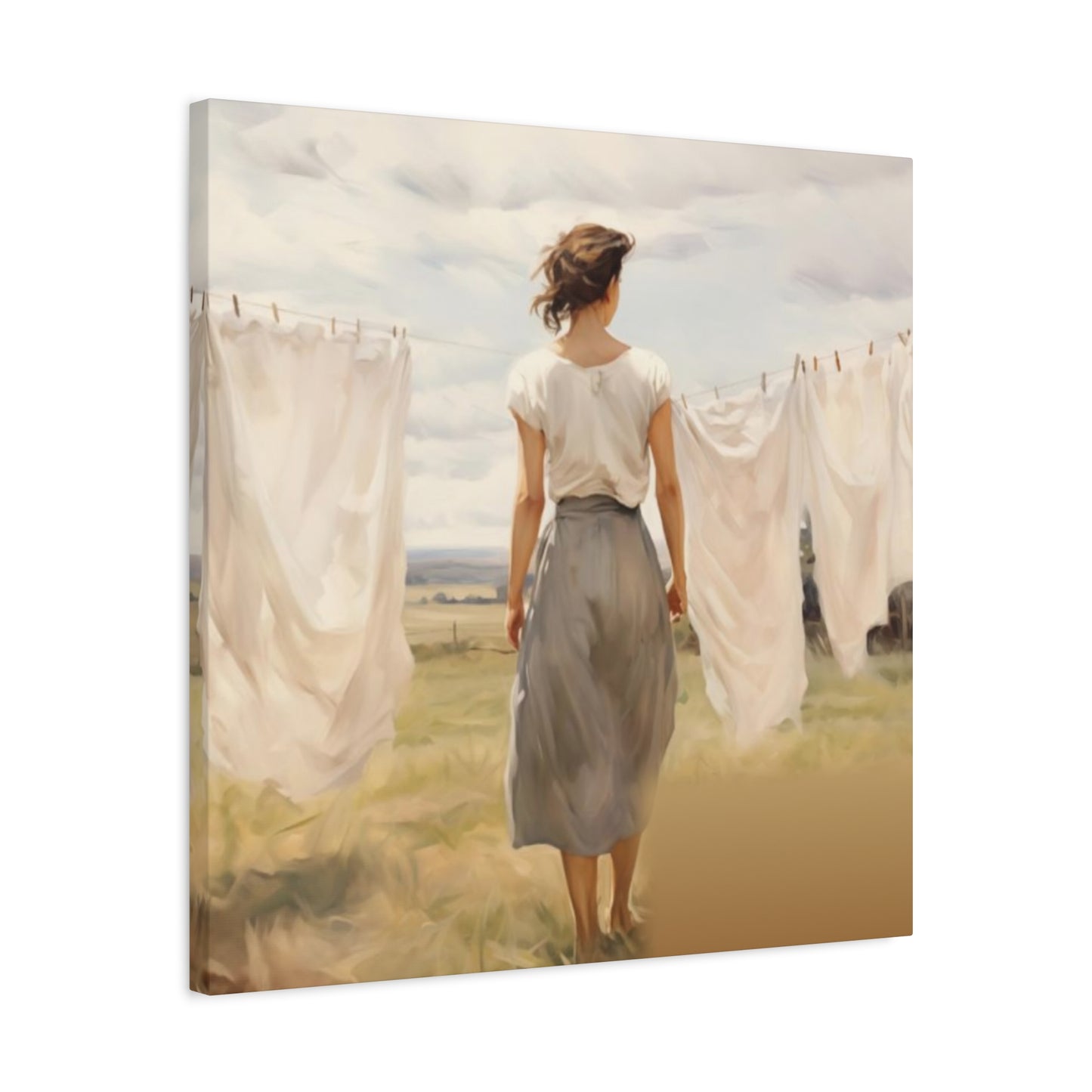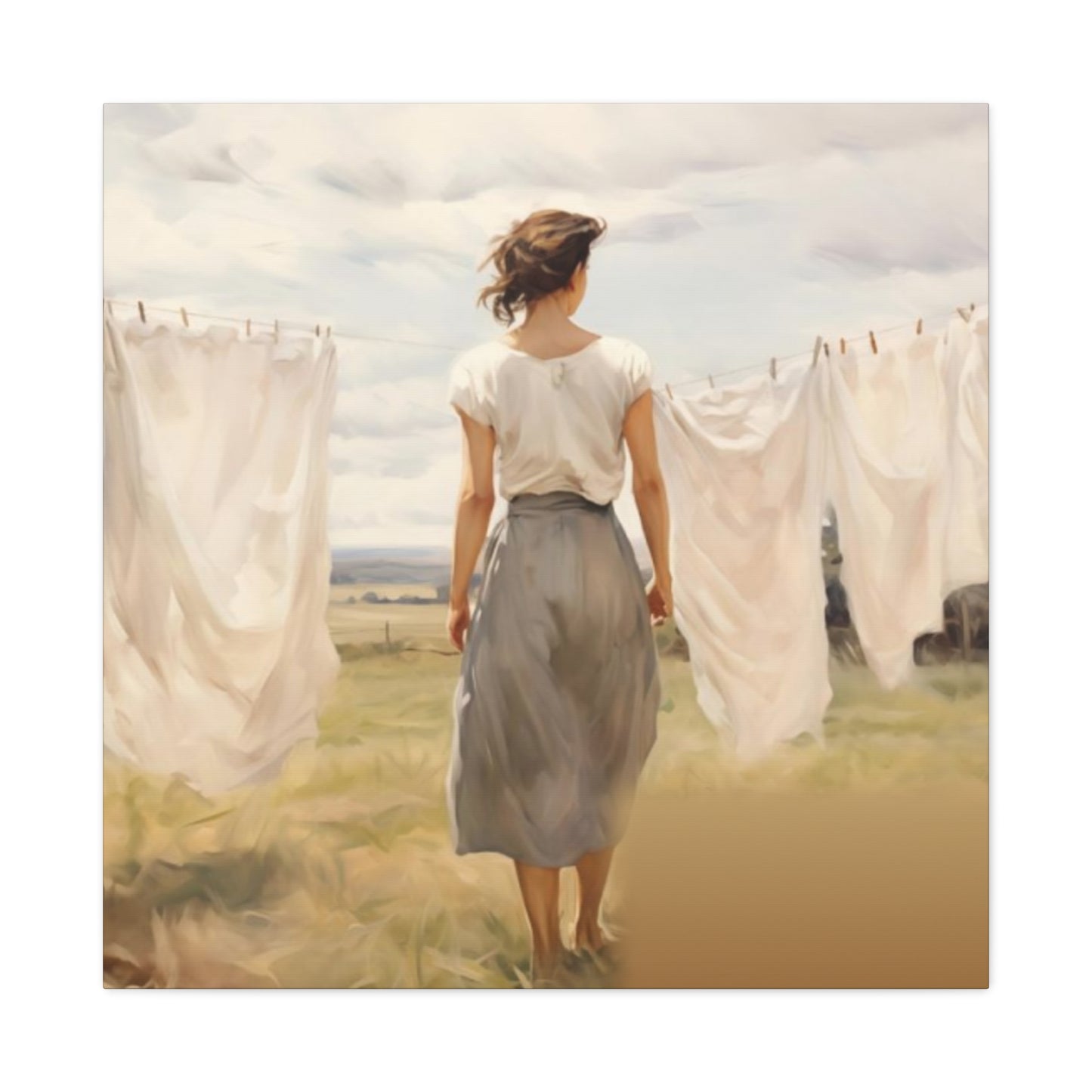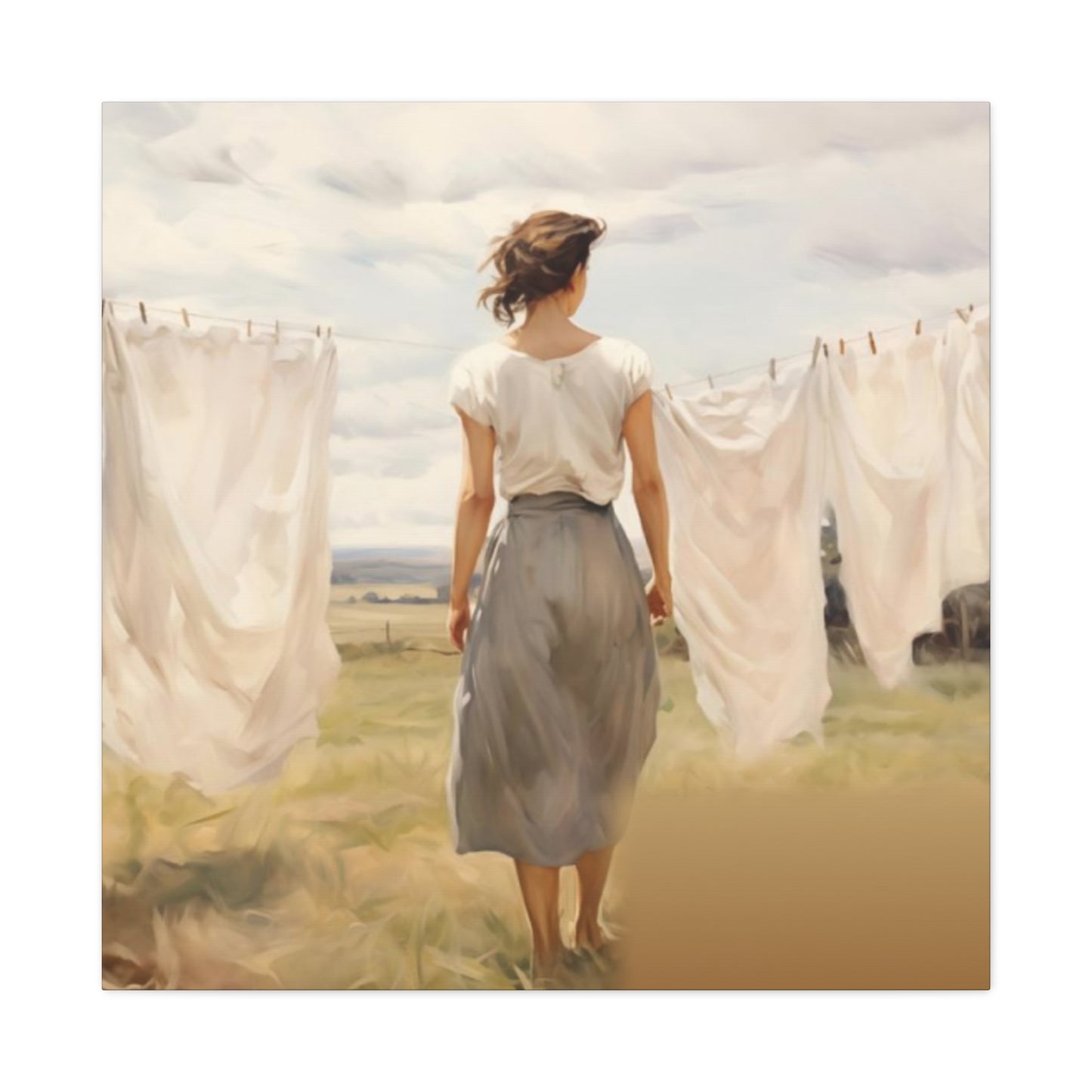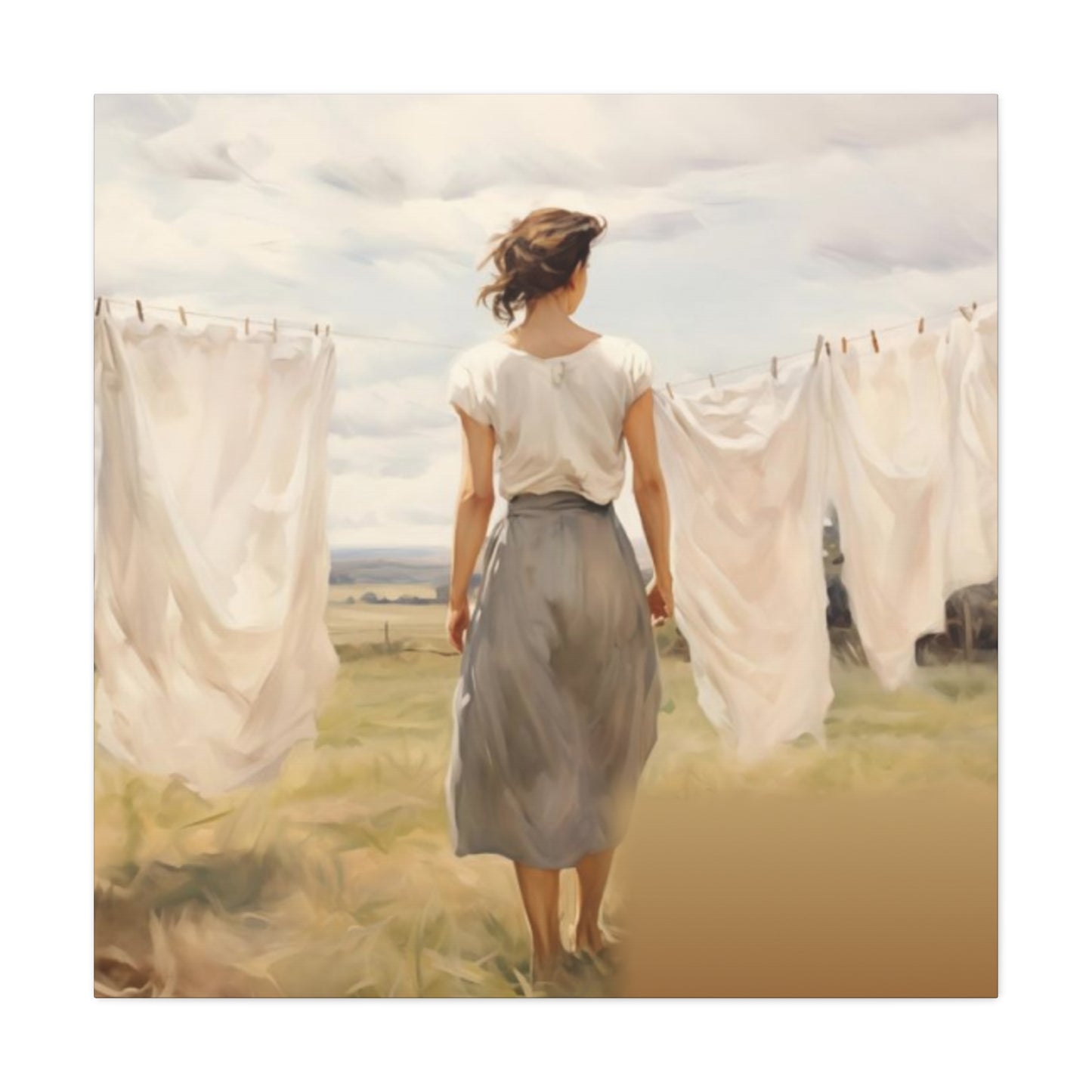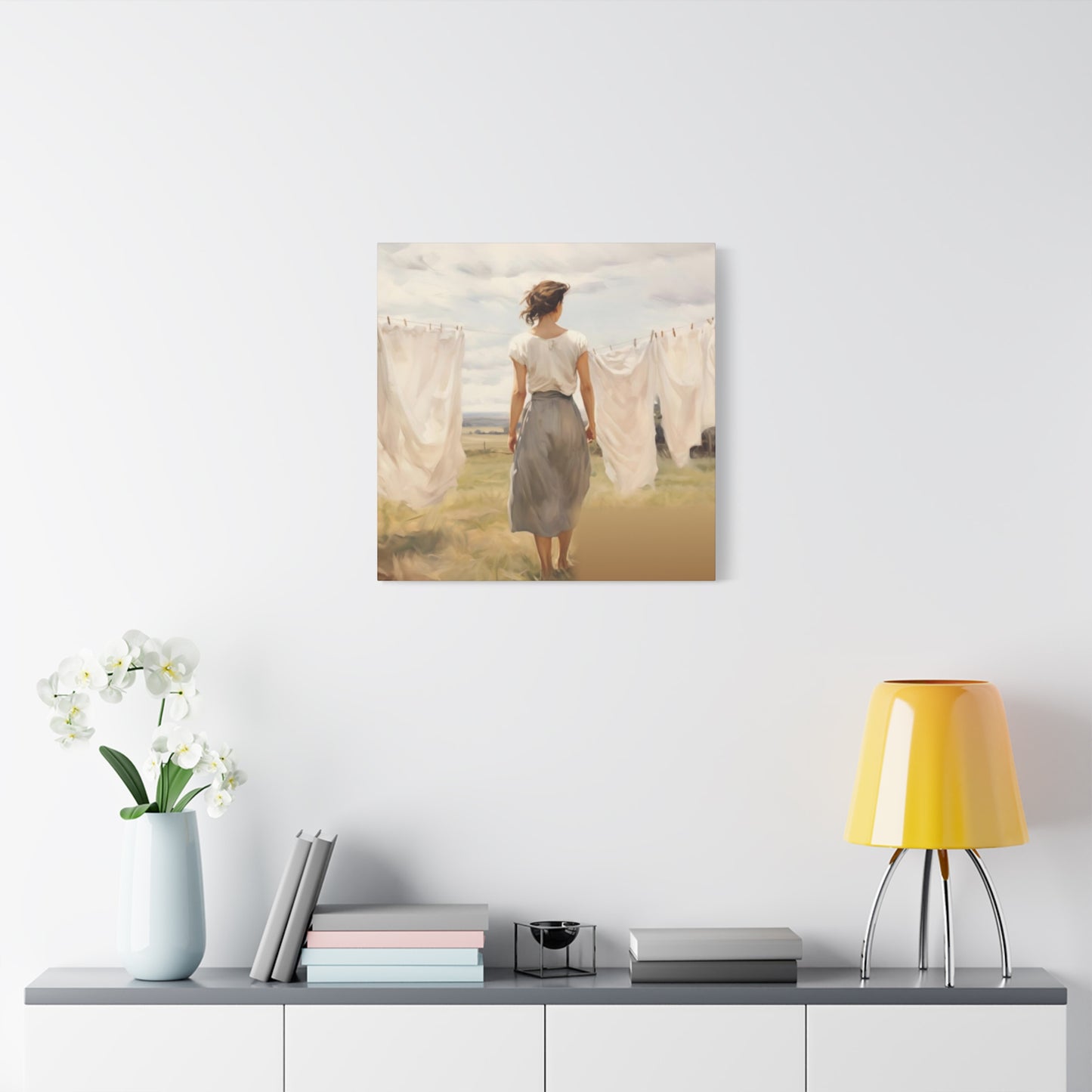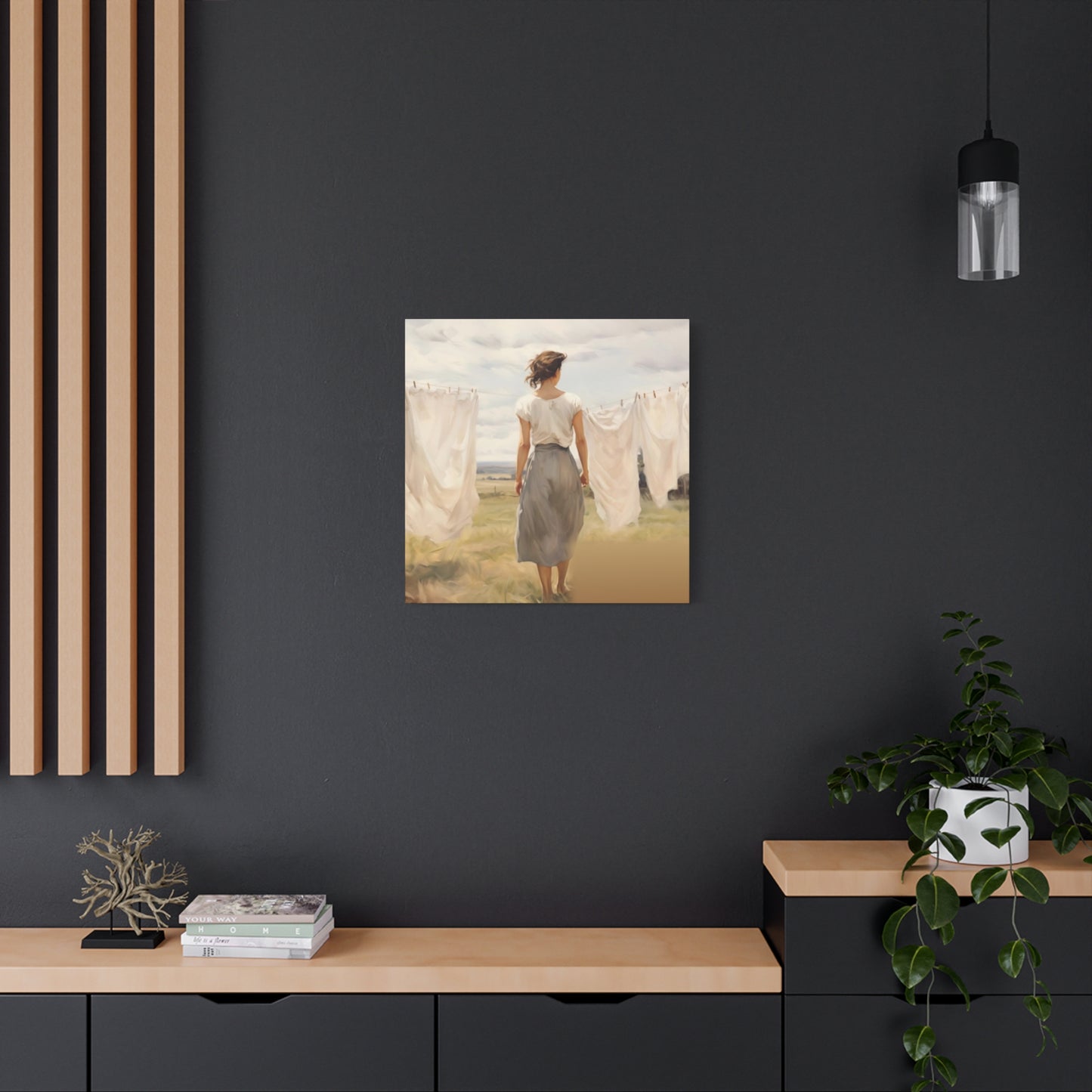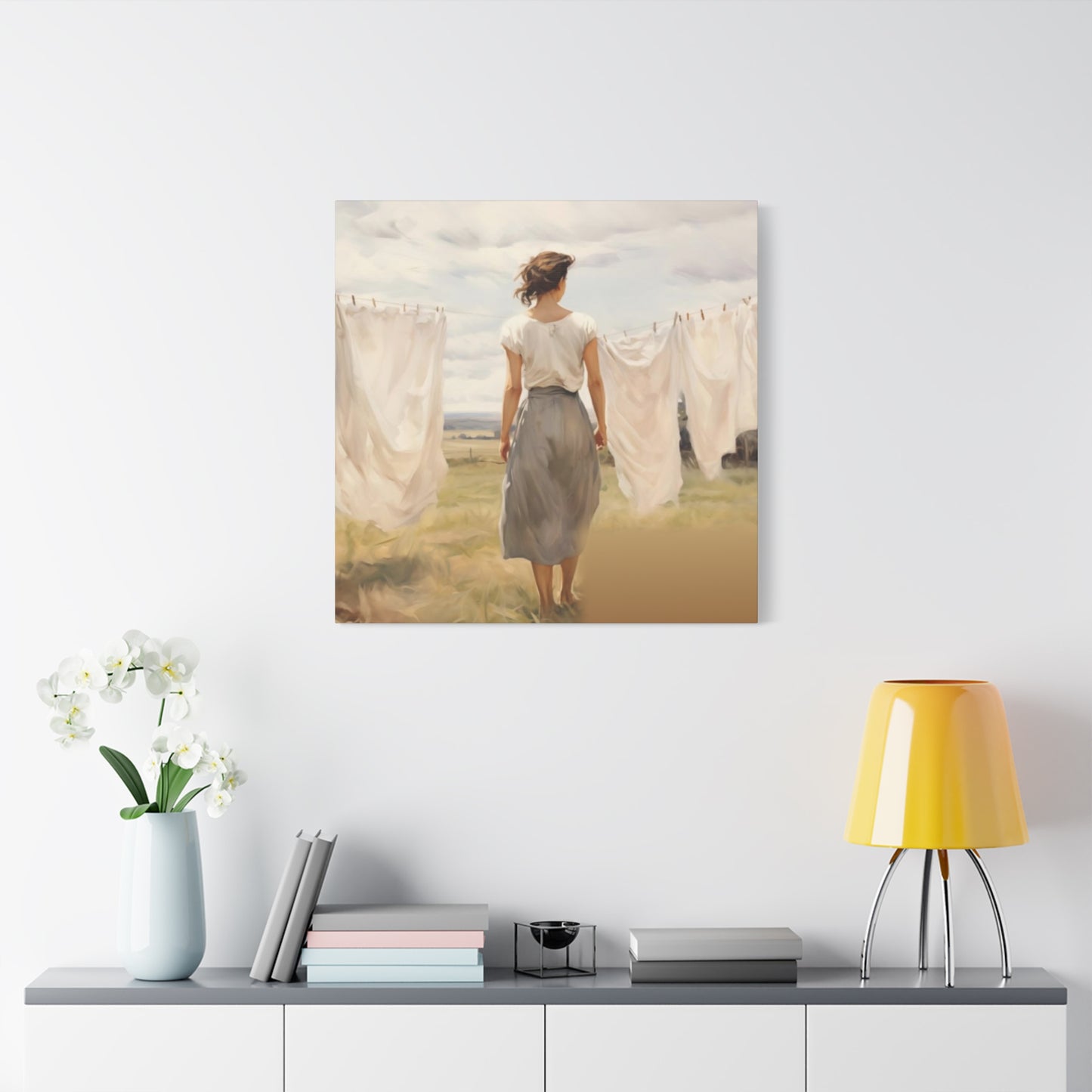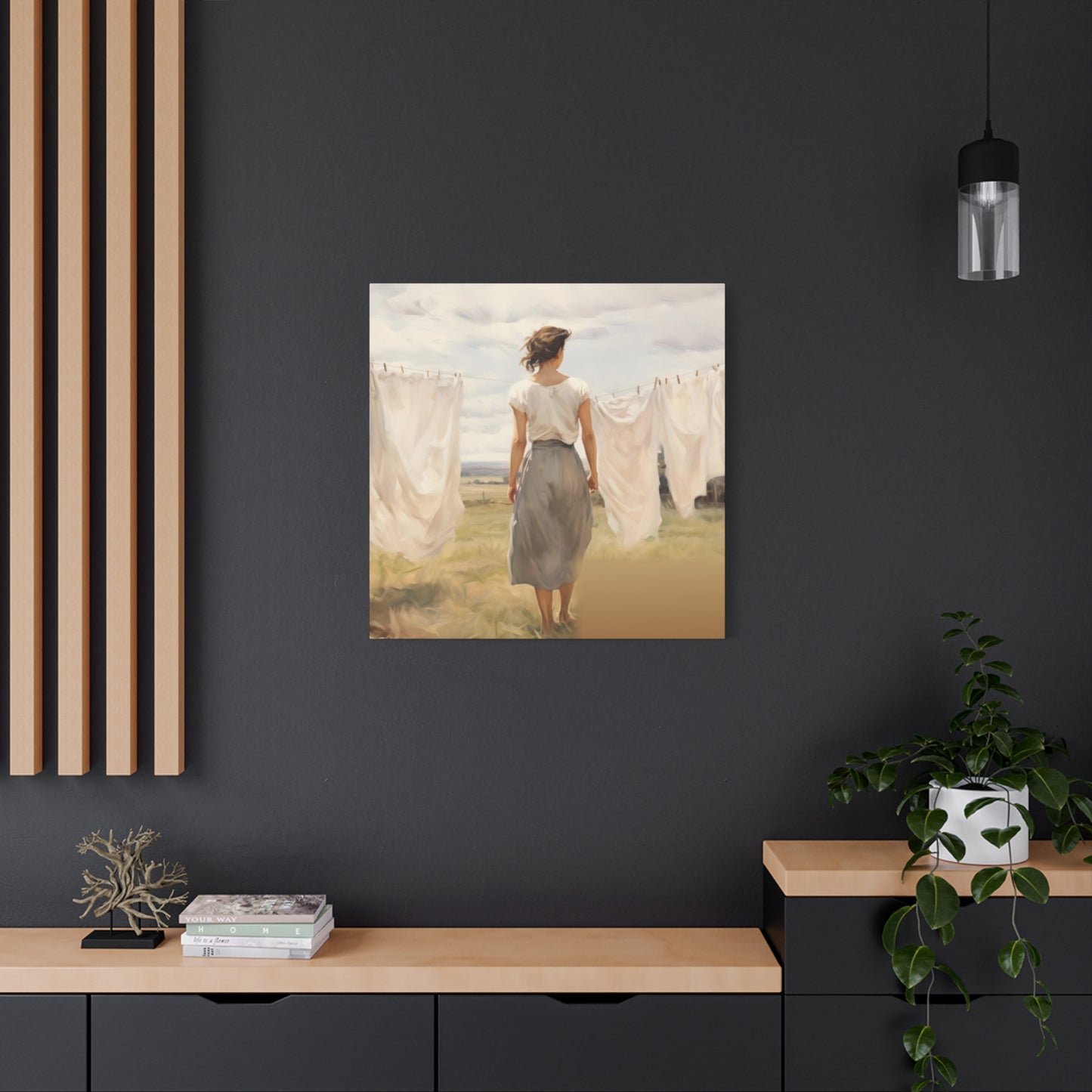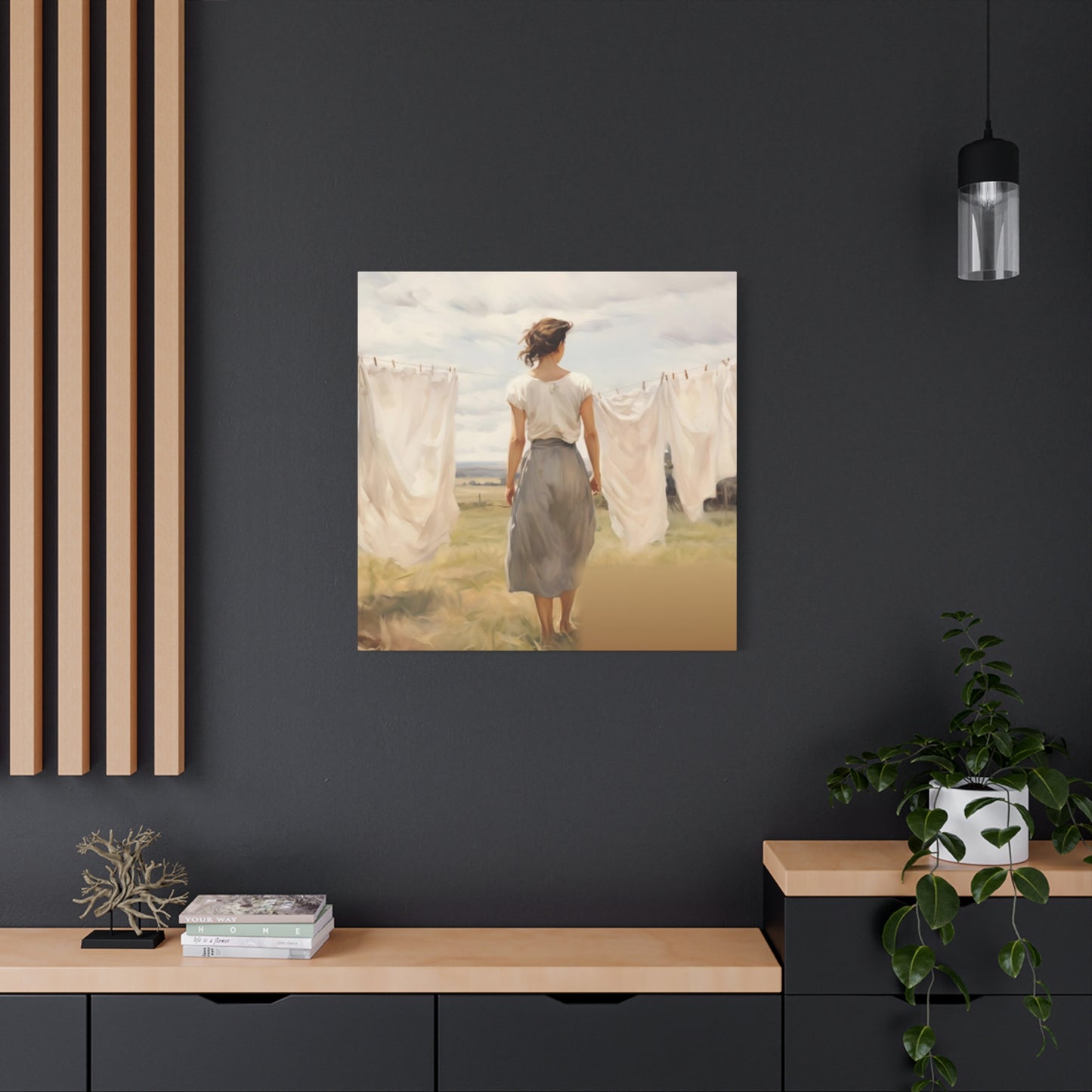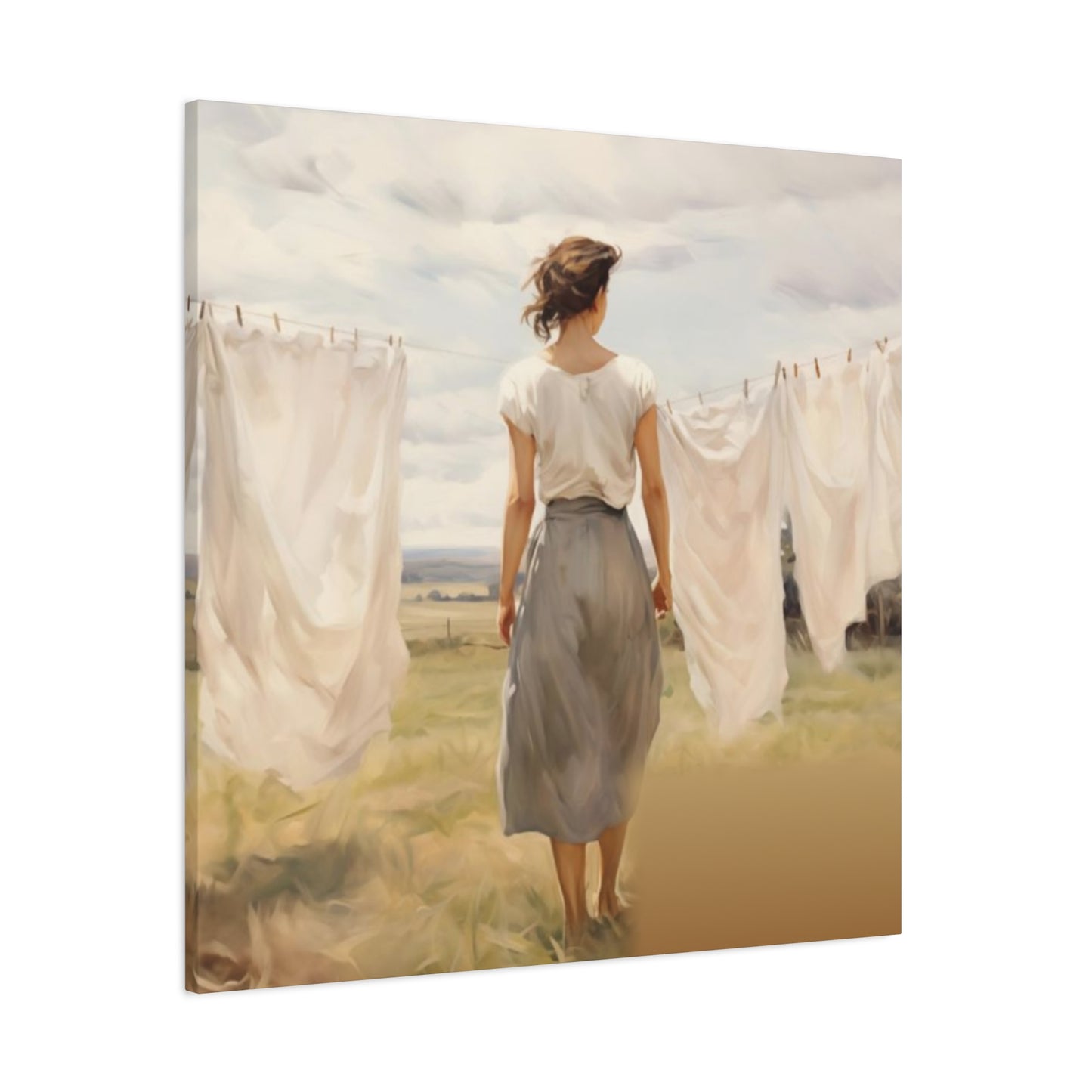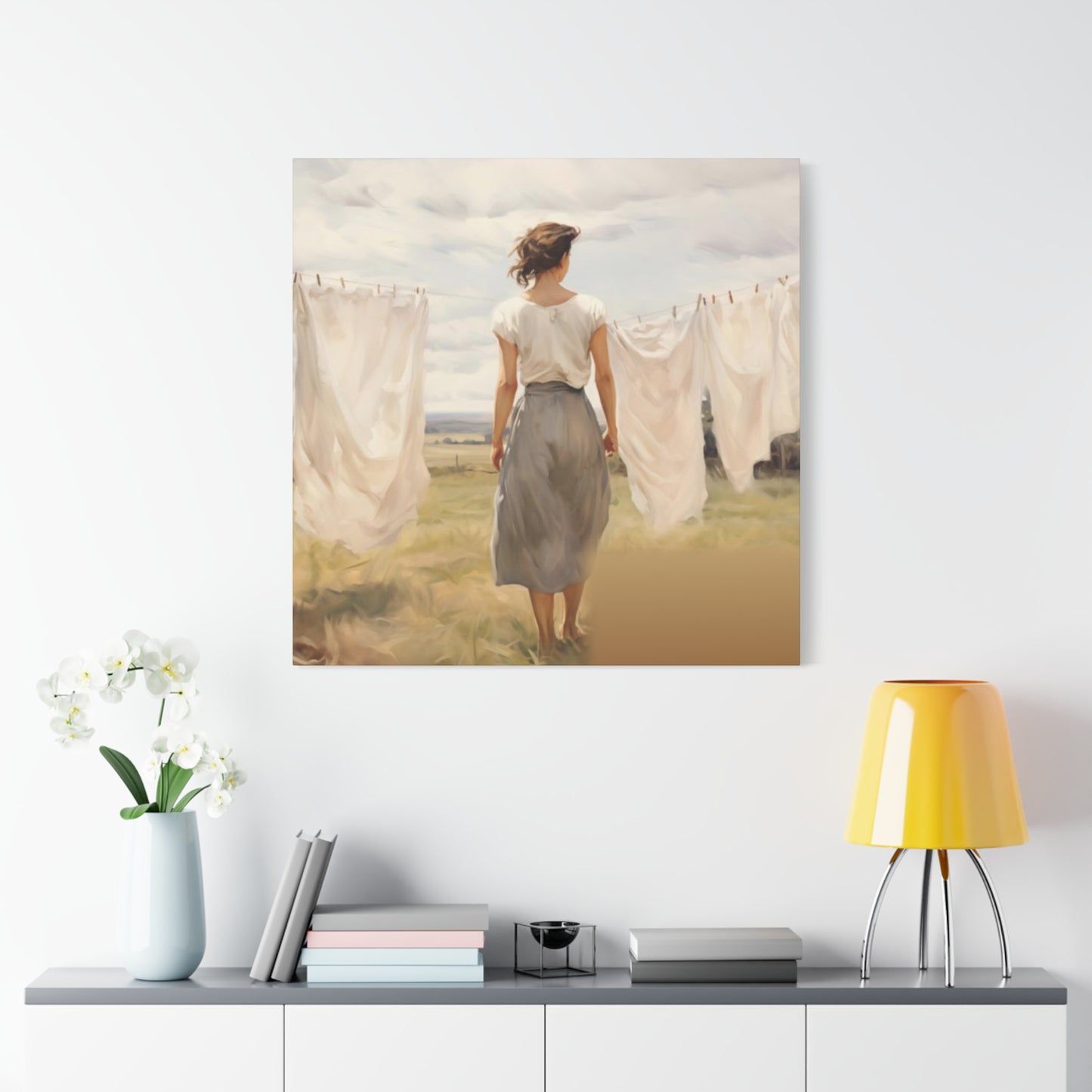Simplicity in Art: How 'Women Drying White Clothes' Wall Art Brings Subtle Beauty to Your Home Decor
The visual representation of women drying white clothes has emerged as a captivating subject matter in contemporary wall art, creating a bridge between everyday domestic life and sophisticated artistic expression. This particular genre of canvas prints captures the essence of traditional household activities while transforming them into elegant decorative pieces that resonate with modern audiences. The imagery evokes nostalgia, simplicity, and the beauty found in ordinary moments, making it an increasingly popular choice for homeowners seeking to infuse their spaces with warmth and character.
These artistic representations celebrate the ritualistic nature of laundry care, portraying women engaged in the timeless task of hanging freshly washed garments to dry in natural sunlight. The visual narrative often depicts scenes of domestic tranquility, where white linens flutter gently in the breeze against backdrops of rustic landscapes, Mediterranean villages, or simple backyard settings. The aesthetic appeal lies not only in the nostalgic subject matter but also in the artistic interpretation of light, texture, and composition that elevates these everyday scenes into gallery-worthy pieces.
The popularity of such artwork stems from its ability to connect viewers with simpler times while maintaining relevance in contemporary interior design schemes. Whether displayed in laundry rooms, kitchens, bedrooms, or living areas, these canvas prints serve as conversation starters and focal points that add depth and personality to any space. The universal nature of the subject matter transcends cultural boundaries, making it accessible and meaningful to diverse audiences who appreciate both its aesthetic qualities and emotional resonance.
Understanding the Historical Context of Laundry Art in Visual Culture
Throughout art history, domestic scenes featuring women performing household tasks have been documented across various periods and artistic movements. From Dutch Golden Age paintings to Impressionist masterpieces, the representation of laundry activities has served as both social commentary and aesthetic exploration. Artists have long been fascinated by the interplay of light on white fabrics, the graceful movements of figures engaged in physical labor, and the atmospheric qualities of outdoor washing and drying scenes.
The tradition of depicting women drying white clothes gained particular prominence during the nineteenth and early twentieth centuries when laundry was an elaborate weekly ritual that often involved entire communities. Artists captured these scenes with remarkable attention to detail, documenting not just the physical act of hanging clothes but also the social interactions, environmental conditions, and cultural practices associated with this essential household task. These historical artworks now inspire contemporary canvas prints that reimagine these classic scenes for modern interiors.
In many European villages, particularly in Mediterranean regions, the sight of white laundry hanging from windows and balconies became an iconic visual element that artists frequently incorporated into their compositions. This architectural integration of functional necessity with visual beauty created a distinctive aesthetic that continues to captivate contemporary viewers. Modern interpretations of these scenes maintain the romantic quality of the originals while adapting the style and presentation to suit current design preferences and printing technologies.
The cultural significance of laundry imagery extends beyond mere documentation of daily life to encompass themes of femininity, labor, domesticity, and the beauty inherent in routine activities. Contemporary artists and photographers continue to explore these themes, creating fresh perspectives on traditional subjects that resonate with audiences seeking meaningful connections to heritage and everyday experiences. The enduring appeal of such imagery demonstrates the universal nature of domestic experiences and the artistic potential found in seemingly mundane activities.
Artistic Techniques and Styles in Laundry Wall Art Canvas Prints
The production of canvas prints featuring women drying white clothes encompasses a wide range of artistic techniques and stylistic approaches. Traditional oil painting effects remain popular, with digital artists recreating the brushwork, texture, and color palettes characteristic of classical artistic methods. These reproductions capture the richness and depth of original paintings while offering the accessibility and affordability of modern printing technologies, allowing more people to enjoy museum-quality artwork in their homes.
Photographic interpretations represent another significant category within this genre, where contemporary photographers capture real scenes of laundry drying in various locations around the world. These images may be presented in their natural color palette or processed with vintage effects, sepia tones, or black and white treatments that enhance their nostalgic appeal. The photographic approach brings authenticity and immediacy to the subject matter while allowing for creative manipulation through digital editing techniques that emphasize particular moods or aesthetic qualities.
Watercolor styles have gained considerable popularity in recent years, offering a softer, more ethereal interpretation of laundry scenes. The translucent quality of watercolor effects creates a dreamy atmosphere that complements the lightness and airiness associated with freshly laundered white fabrics dancing in the breeze. Artists working in this medium often emphasize the play of natural light through the textiles, creating luminous compositions that bring a sense of freshness and purity to interior spaces.
Abstract and contemporary interpretations push the boundaries of traditional laundry imagery by deconstructing the subject matter into geometric forms, bold color blocks, or minimalist compositions that capture the essence of the scene without literal representation. These modern approaches appeal to collectors who appreciate conceptual art and seek pieces that complement contemporary interior design schemes while maintaining a connection to the traditional subject matter through subtle references and symbolic elements.
Color Palettes and Their Impact on Interior Atmosphere
The dominant presence of white in laundry-themed artwork creates a foundation of purity, cleanliness, and simplicity that influences the overall atmospheric quality of the piece. However, the surrounding color elements significantly affect how these prints interact with interior spaces and influence mood. Backgrounds may feature soft blues reminiscent of clear skies, warm earth tones suggesting Mediterranean landscapes, or muted grays that create sophisticated urban aesthetics, each option producing distinctly different emotional responses from viewers.
Artists often incorporate complementary colors to enhance the visual impact of white laundry against contrasting backgrounds. Azure blues, sage greens, terracotta oranges, and weathered wood tones frequently appear in compositions, creating harmonious color relationships that prevent the predominance of white from appearing stark or clinical. These carefully chosen palettes ensure that the artwork integrates seamlessly with various interior design schemes while maintaining visual interest and depth.
Seasonal variations in color treatment allow for diverse interpretations of the same basic subject matter. Summer scenes might feature brilliant blue skies and vibrant green vegetation, creating energetic and uplifting compositions. Autumn representations could incorporate golden light and warm amber tones that suggest late afternoon sunshine. Winter interpretations might employ cooler color temperatures with gray skies and muted backgrounds, while spring versions could include fresh pastels and new growth that symbolize renewal and freshness.
The psychological impact of these color choices extends beyond mere aesthetic preference to influence the functional atmosphere of spaces where the artwork is displayed. Cool color palettes create calming environments suitable for bedrooms and relaxation areas, while warmer tones generate welcoming atmospheres in gathering spaces. Understanding these color psychology principles helps homeowners select artwork that not only complements their decor but also supports the intended emotional tone of each room.
Sizing Considerations for Maximum Visual Impact
Selecting the appropriate size for canvas prints featuring women drying white clothes requires careful consideration of wall dimensions, viewing distances, and the desired prominence of the artwork within the space. Large-scale pieces measuring forty-eight inches or more in width create dramatic focal points suitable for expansive walls in living rooms, dining areas, or open-concept spaces where they can be appreciated from various distances. These substantial works command attention and establish the thematic direction for entire rooms.
Medium-sized prints ranging from twenty-four to forty-eight inches offer versatility for standard residential spaces, fitting comfortably above furniture pieces, in hallway galleries, or as components of multi-piece arrangements. This size category provides sufficient detail and visual presence without overwhelming moderate wall spaces, making it the most popular choice for typical home environments. The balanced proportions allow for comfortable viewing while maintaining the artistic integrity of the composition.
Small-scale options under twenty-four inches work effectively in intimate settings such as powder rooms, closets, laundry areas, or as part of gallery wall collections where multiple pieces create cumulative impact. These compact sizes allow for creative clustering arrangements that build visual interest through repetition and variation. Despite their smaller footprint, quality printing techniques ensure that detail and artistic merit remain fully appreciable at appropriate viewing distances.
The relationship between artwork size and furniture scale deserves particular attention when planning installations. General design principles suggest that artwork spanning approximately two-thirds to three-quarters of the furniture width beneath it creates pleasing visual proportions. However, contemporary design increasingly embraces oversized pieces that extend beyond traditional boundaries, creating bold statements that reflect current aesthetic preferences for drama and impact in interior spaces.
Material Quality and Canvas Print Construction Methods
High-quality canvas prints utilize premium cotton or polyester-cotton blend materials that provide optimal surface texture for reproducing fine art images. Pure cotton canvases offer superior archival qualities with natural fibers that resist yellowing and deterioration over extended periods. The woven texture of canvas material adds dimensional depth to printed images, creating a tactile quality that enhances the perception of artistic authenticity and connects viewers more intimately with the artwork.
The printing process itself significantly influences the final quality and longevity of canvas artwork. Giclée printing technology represents the gold standard for fine art reproduction, utilizing specialized inkjet printers that deposit microscopic droplets of pigment-based inks onto canvas surfaces. This method produces exceptional color accuracy, smooth tonal gradations, and remarkable detail resolution that rivals original paintings. Museums and professional artists frequently specify giclée printing for limited edition reproductions due to its superior quality and archival stability.
Protective coatings applied after printing serve multiple functions in preserving canvas artwork and enhancing its visual qualities. UV-resistant treatments protect colors from fading due to sunlight exposure, significantly extending the display life of prints in bright environments. Water-resistant coatings provide additional protection against humidity and minor spills, particularly important for pieces displayed in kitchens, laundry rooms, or bathrooms where moisture levels fluctuate. Some finishes also enhance color vibrancy or add subtle sheen that mimics the appearance of varnished oil paintings.
Stretching and mounting techniques determine both the presentation style and structural integrity of canvas prints. Gallery wrap construction extends the printed image around the edges of supporting frames, creating a contemporary finished appearance that requires no additional framing. Traditional stretching maintains the image within the flat frontal plane, with neutral-colored edges suitable for framed presentation. The quality of stretcher bars, corner keys for tension adjustment, and secure stapling methods all contribute to preventing warping, sagging, or corner distortion over time.
Framing Options to Enhance Laundry Artwork Presentation
While many canvas prints are designed for frameless display with gallery-wrapped edges, traditional framing offers additional protective and aesthetic benefits worth considering. Floating frames create a sophisticated presentation where a small gap appears between the canvas edge and the frame, allowing the artwork to appear suspended within its border. This contemporary mounting style adds visual depth and emphasizes the three-dimensional quality of canvas material while providing structural support and edge protection.
Classic wooden frames in natural finishes complement the rustic, traditional nature of laundry-themed artwork beautifully. Oak, pine, or reclaimed wood frames enhance the nostalgic quality of the imagery while adding warmth and organic texture to the overall presentation. The natural grain patterns and color variations in wood materials create subtle visual interest that supports rather than competes with the artwork, making wooden frames an enduringly popular choice for this subject matter.
Painted frames in white, black, or metallic finishes offer alternatives for different interior design schemes and personal preferences. White frames create cohesive presentations with the white laundry depicted in the artwork, establishing visual continuity and reinforcing the theme of cleanliness and purity. Black frames provide dramatic contrast that makes colors appear more vibrant while adding contemporary sophistication. Metallic finishes in silver, gold, or bronze introduce elegance and refinement suitable for more formal interior settings.
The decision between framing and frameless presentation ultimately depends on personal preference, interior design style, and practical considerations regarding wall color, surrounding decor, and the specific characteristics of the artwork itself. Some pieces benefit from the clean, uninterrupted edges of gallery-wrapped canvases, while others gain visual structure and protection from carefully selected frames. Experimenting with different presentation options through digital visualization tools or physical samples helps ensure satisfaction with the final installation.
Ideal Room Placements for Laundry Wall Art
Laundry rooms and utility spaces represent the most thematic locations for artwork depicting women drying white clothes, creating cohesive environments where form meets function. Displaying such imagery in these practical spaces elevates mundane household tasks by surrounding them with beauty and artistry. The visual reminder of traditional laundry methods can inspire appreciation for modern conveniences while maintaining connection to domestic heritage and the satisfaction of caring for home and family.
Kitchen environments provide excellent contexts for laundry-themed artwork, as both spaces share associations with domestic care, cleanliness, and nurturing activities. The neutral color palette of white laundry complements common kitchen color schemes while adding visual interest to walls that might otherwise remain blank. Placement near windows where natural light illuminates the artwork creates particularly appealing effects that echo the outdoor settings often depicted in the images themselves.
Bedroom installations of laundry canvas prints emphasize themes of rest, cleanliness, and the comfort of fresh linens. The peaceful nature of laundry drying scenes contributes to the relaxing atmosphere appropriate for sleeping quarters. Positioning such artwork above beds or dressers reinforces the connection between the depicted activity and the actual use of clean, fresh bedding and clothing that contributes to restful sleep and personal care.
Living rooms and family gathering spaces benefit from the conversational nature of laundry artwork, which often prompts discussion about personal memories, cultural traditions, and changing domestic practices. The universal familiarity of the subject matter makes it accessible to diverse guests while adding personality and narrative interest to entertainment areas. Strategic placement as focal points above sofas, mantels, or featured walls establishes visual hierarchies that guide attention and create balanced, intentional interior compositions.
Creating Gallery Walls with Laundry Themed Canvas Prints
Gallery wall arrangements offer creative opportunities to display multiple pieces of laundry-themed artwork in cohesive, visually compelling compositions. Combining various sizes, orientations, and stylistic interpretations of the basic subject matter creates dynamic wall installations that maintain thematic unity while providing visual variety. The repetition of white laundry elements across multiple pieces establishes continuity, while differences in composition, color palette, and perspective prevent monotony and maintain viewer interest.
Symmetrical gallery arrangements provide formal, balanced presentations suitable for traditional interior styles and spaces where orderliness is valued. Matching pairs of identically sized prints flanking a central larger piece create classic triptych formations. Grid patterns with evenly spaced frames of uniform size produce clean, organized appearances that appeal to minimalist sensibilities. These structured approaches to multiple artwork display create predictable visual rhythms that contribute to calm, orderly environmental atmospheres.
Asymmetrical salon-style galleries embrace a more eclectic, collected-over-time aesthetic that adds personality and creative energy to spaces. Mixing different sizes, frame styles, and even related subject matter beyond strictly laundry themes creates visually interesting compositions that reward extended viewing. The key to successful asymmetrical arrangements lies in maintaining balanced visual weight across the overall composition while allowing individual pieces their own presence and impact within the collective display.
Planning gallery wall installations requires careful measurement, layout visualization, and execution techniques that ensure satisfactory results. Creating paper templates matching frame sizes and arranging them on walls with removable tape allows experimentation with different configurations before committing to permanent installation. Digital planning tools and smartphone applications designed for gallery wall design provide additional resources for visualizing arrangements and ensuring proper spacing, alignment, and overall compositional balance.
Complementary Decor Elements for Cohesive Interior Styling
Successfully integrating laundry-themed wall art into comprehensive interior design schemes requires thoughtful selection of complementary decorative elements that reinforce the thematic and aesthetic qualities of the artwork. Vintage laundry tools such as antique washboards, wooden clothespins, or galvanized metal tubs displayed as decorative objects create tangible connections to the traditional practices depicted in the artwork. These functional antiques add dimensional interest and authentic historical character to themed spaces.
Textile selections play crucial roles in supporting laundry artwork themes throughout interior spaces. Linen and cotton fabrics in natural or white tones echo the materials depicted in the prints while contributing to cohesive color schemes. Incorporating actual vintage linens as decorative elements—perhaps draped over furniture, displayed on quilt ladders, or used as window treatments—creates literal interpretations of the artwork subject matter that strengthen thematic unity and add layers of visual interest.
Natural materials including wood, wicker, and wrought iron complement the rustic, traditional aesthetic commonly associated with laundry imagery. Furniture pieces in weathered or distressed finishes, woven baskets for storage, and metal accents in aged patinas create environments that feel collected over time rather than instantaneously decorated. These material choices support the nostalgic qualities of the artwork while providing practical functionality appropriate to modern living requirements.
Color coordination between wall art and surrounding decor establishes visual harmony throughout spaces. Identifying secondary colors from the artwork and repeating them in throw pillows, area rugs, pottery, or other decorative accessories creates intentional design relationships that demonstrate careful planning and aesthetic consideration. However, avoiding overly matchy approaches by varying shades, textures, and scales of repeated colors prevents spaces from appearing contrived or overly coordinated.
Benefits of Domestic Art in Living Spaces
Displaying artwork that depicts everyday domestic activities creates psychological connections between inhabitants and their living environments. The familiar subject matter of women drying white clothes triggers personal memories and associations related to home, family, and care-taking traditions. These emotional responses contribute to feelings of belonging, comfort, and rootedness that transform houses into homes imbued with personal meaning beyond mere functional shelter.
The representation of productive domestic labor in artistic form validates and elevates household work that is often undervalued in contemporary culture. Seeing these activities portrayed as worthy subjects of artistic attention affirms their importance and the contributions of those who perform them. This validation can foster greater appreciation for the care and effort involved in maintaining comfortable, clean, organized living environments, potentially influencing attitudes toward domestic responsibilities.
The visual qualities of laundry imagery—particularly the predominance of white and the outdoor settings often depicted—create associations with cleanliness, freshness, and purity that psychologically reinforce the actual cleanliness of living spaces. The calming nature of pastoral scenes and the gentle movement suggested by hanging fabrics contribute to relaxing atmospheric qualities that reduce stress and promote tranquility. These psychological effects make laundry-themed artwork particularly suitable for spaces designated for rest, renewal, and escape from external pressures.
The nostalgic dimension of traditional laundry scenes provides emotional refuge in increasingly fast-paced, technology-dominated modern life. Viewing representations of simpler times and more deliberate, physical approaches to household tasks offers psychological respite and perspective on contemporary conveniences. This temporal contrast encourages mindfulness and gratitude while maintaining connections to cultural heritage and generational continuity through shared domestic experiences.
Seasonal Variations in Laundry Art Imagery and Display
The changing seasons offer opportunities to rotate laundry-themed artwork or select pieces that reflect particular times of year. Summer imagery featuring brilliant blue skies, lush green vegetation, and bright sunlight creates energetic, vibrant atmospheres appropriate to the season's warmth and extended daylight hours. These compositions often depict Mediterranean or coastal settings where outdoor laundry drying remains common practice, evoking vacation memories and warm-weather leisure.
Autumn interpretations incorporate golden afternoon light, harvest colors, and transitional weather conditions that suggest approaching cooler seasons. The quality of light in these pieces tends toward warmth and richness, with longer shadows and amber tones that create cozy, welcoming atmospheres. Vegetation in autumn laundry scenes may show seasonal changes with yellowing leaves or harvested fields visible in backgrounds, grounding the timeless domestic activity within specific temporal contexts.
Winter representations present unique atmospheric qualities with overcast skies, bare trees, and perhaps frost or snow visible in backgrounds. The contrast between white laundry and winter landscapes creates striking visual effects while emphasizing the hardiness required for outdoor drying in cold conditions. These pieces often convey determination, resilience, and the continuation of necessary tasks regardless of challenging circumstances, themes that resonate with viewers facing their own seasonal challenges.
Spring scenes celebrate renewal, fresh growth, and the return of pleasant weather after winter's constraints. Budding trees, blooming flowers, and vibrant new green vegetation frequently appear in backgrounds of spring laundry imagery. The symbolism of fresh starts, cleaning, and preparation for warmer seasons aligns perfectly with spring cleaning traditions, making such artwork particularly meaningful during transitional periods when homes receive thorough seasonal attention and refreshment.
Cultural Variations in Laundry Practices and Artistic Representation
Mediterranean countries, particularly Italy and Greece, have contributed significantly to the iconic imagery of laundry hanging from windows, balconies, and between buildings in densely populated villages. The architectural integration of this functional necessity into urban landscapes created distinctive visual environments that artists and photographers have documented extensively. These representations capture not only the practical activity but also the social dimensions of communities where domestic life unfolds in semi-public spaces visible to neighbors and passersby.
Asian interpretations of laundry themes often emphasize communal washing areas, rivers and streams used for cleaning clothes, and the social interactions among women gathering for this shared task. The artistic representation of these scenes highlights both the physical labor involved and the community bonds strengthened through collective work. Contemporary artists from Asian cultures continue exploring these themes while addressing changes in domestic practices resulting from urbanization and modernization.
Rural American traditions of clothesline laundry in farmyard settings provide distinctly different aesthetic contexts compared to urban European scenes. Wide open spaces, simple wooden houses, and agricultural backgrounds characterize these representations, which often emphasize self-sufficiency, connection to land, and the rhythms of rural life. The imagery evokes nostalgia for agrarian lifestyles and simpler times while celebrating the beauty found in ordinary farm household routines.
African artistic interpretations of laundry activities frequently depict communal gathering at water sources, with vibrant colors in both clothing and surrounding environments. The social and ceremonial aspects of washing clothes often receive particular emphasis, highlighting the importance of these activities beyond mere practical necessity. Contemporary African artists increasingly explore these traditional subjects through modern artistic lenses, creating powerful commentaries on continuity and change in domestic practices.
Technical Considerations for Photograph-Based Laundry Art
Photographers capturing original laundry scenes for artistic reproduction must consider numerous technical factors affecting image quality and aesthetic impact. Lighting conditions dramatically influence the mood and visual qualities of photographs, with soft morning or late afternoon light generally producing more pleasing results than harsh midday sun. The direction of light relative to white fabrics determines whether they appear luminous and translucent or flat and opaque, significantly affecting the overall atmospheric quality of images.
Compositional decisions regarding framing, perspective, and focal points guide viewer attention and determine narrative emphasis within photographs. Close-up compositions highlighting textile textures and the details of clothespins or hangers create intimate, detail-oriented imagery. Mid-range views showing figures engaged in hanging laundry emphasize the human activity and labor involved. Wide-angle perspectives including architectural or landscape contexts situate the domestic activity within broader environmental and cultural settings.
Depth of field choices influence which elements appear sharp and which dissolve into soft focus, directing attention and creating visual hierarchy within compositions. Shallow depth of field isolates specific elements—perhaps a particular garment or the face of a woman hanging laundry—while rendering backgrounds as soft, unobtrusive contexts. Greater depth of field maintains sharpness throughout the image, providing clear information about entire scenes and allowing viewers to explore various elements across the composition.
Post-processing treatments transform raw photographic captures into finished artistic works suitable for canvas printing. Color grading establishes mood through adjustments to temperature, saturation, and individual color channels. Contrast manipulation enhances tonal range and creates more dramatic or subtle presentations depending on artistic intentions. Texture overlays, film grain effects, and vintage treatments can establish nostalgic qualities that enhance the emotional resonance of laundry imagery for contemporary audiences.
Environmental and Sustainability Themes in Laundry Artwork
Contemporary interest in sustainable living practices has added new dimensions of meaning to artwork depicting traditional air-drying methods for laundry. These images now serve as visual reminders of environmentally friendly alternatives to energy-intensive electric dryers, aligning with growing consciousness about domestic energy consumption and carbon footprints. Displaying such artwork can function as both aesthetic choice and subtle advocacy for more sustainable household practices.
The symbolic association between clean white laundry and environmental purity creates layered meanings in contemporary contexts. Fresh air, natural sunlight, and outdoor spaces depicted in laundry scenes evoke unpolluted environments and connection to nature increasingly threatened by industrialization and climate change. These images can inspire appreciation for clean air and water resources essential to traditional laundry practices, fostering environmental awareness through artistic engagement rather than didactic messaging.
Artists increasingly approach laundry themes with explicit environmental commentary, creating works that juxtapose traditional drying methods with contemporary urban environments or incorporate references to pollution, resource scarcity, and climate concerns. These pieces maintain aesthetic appeal while engaging viewers in important conversations about sustainability, lifestyle choices, and the environmental implications of mundane daily decisions regarding household tasks and resource consumption.
The handcrafted quality of traditional laundry practices depicted in artwork aligns with broader movements toward slower, more intentional lifestyles that prioritize sustainability over convenience. Viewing representations of labor-intensive domestic activities can inspire viewers to reconsider their own household practices, potentially leading to adoption of more environmentally conscious approaches to laundry care and other domestic tasks. Art thus functions not merely as decoration but as catalyst for reflection and behavior change.
Investment Value and Collectibility of Laundry Themed Art
Original paintings and photographs of laundry scenes by recognized artists can represent significant financial investments with potential appreciation over time. Establishing provenance, authenticity, and edition limitations are crucial factors determining investment value for serious collectors. Limited edition prints signed and numbered by artists maintain higher values than unlimited reproductions, though they command correspondingly higher initial purchase prices that may limit accessibility for casual buyers.
The secondary market for vintage laundry-themed artwork has grown as interior designers and collectors recognize the decorative appeal and nostalgic charm of these pieces. Antique shops, estate sales, and online auction platforms offer opportunities to discover original works or early reproductions that carry historical significance beyond their aesthetic qualities. Condition, rarity, and artist recognition significantly influence pricing and collectibility in these secondary markets.
Contemporary artists specializing in laundry themes are developing followings among collectors who appreciate their particular interpretations and technical approaches. Following emerging artists through galleries, art fairs, and online platforms allows collectors to acquire works before artists achieve wider recognition and corresponding price increases. Building relationships with artists and galleries can provide access to new works and special editions before they reach broader markets.
For most homeowners, the primary value of laundry-themed canvas prints lies in their decorative impact and personal meaning rather than financial investment potential. High-quality reproductions offer accessibility to beautiful artwork at price points suitable for typical decorating budgets while providing years of visual enjoyment. The personal satisfaction derived from living with meaningful, aesthetically pleasing artwork represents intangible value that transcends monetary considerations.
Customization Options for Personalized Laundry Wall Art
Many printing services offer customization options allowing customers to personalize laundry-themed artwork to better suit individual preferences and specific design requirements. Color adjustments can modify the palette of existing images to coordinate with particular room colors or personal taste preferences. These modifications might involve shifting the overall temperature toward warmer or cooler tones, adjusting saturation levels, or even converting color images to black and white or sepia treatments for different aesthetic effects.
Text additions allow incorporation of meaningful phrases, family names, or quotations that enhance the personal significance of artwork. Carefully selected typography and placement ensure that text enhancements complement rather than detract from the visual composition. Popular text additions for laundry-themed pieces include vintage-style phrases related to cleanliness, home, or traditional domestic wisdom that reinforce the nostalgic qualities of the imagery.
Custom sizing options accommodate unusual wall dimensions or specific installation requirements that standard sizes cannot address. Having artwork printed to exact specifications ensures perfect fit for particular locations and eliminates the need for compromises regarding scale and proportion. This customization capability is particularly valuable for challenging spaces such as narrow hallways, above doorways, or in rooms with non-standard architectural features.
Creating entirely custom laundry artwork through commissioned photography or illustration provides ultimate personalization, resulting in one-of-a-kind pieces with profound personal meaning. Customers might arrange for photographs of family members engaged in laundry tasks, specific locations with personal significance, or artistic interpretations incorporating particular elements, colors, or styles. While custom commissions require larger investments of time and money, they produce unique artworks unavailable through standard commercial channels.
Maintenance and Care for Canvas Print Longevity
Proper maintenance practices significantly extend the display life and preserve the visual quality of canvas prints. Regular dusting using soft, dry cloths or soft-bristle brushes prevents accumulation of airborne particles that can embed in canvas texture over time. Gentle cleaning motions following the direction of canvas weave protect surface fibers from damage while effectively removing dust. Avoiding chemical cleaners or moisture prevents damage to inks and protective coatings that preserve image quality.
Environmental conditions where artwork is displayed affect longevity substantially. Avoiding direct sunlight exposure prevents fading of colors and degradation of canvas materials despite UV-protective coatings. Maintaining moderate humidity levels prevents moisture-related problems such as mold growth on canvas backing or loosening of stretched canvas from expansion and contraction. Temperature stability similarly protects artwork from stress caused by environmental fluctuations.
Periodic inspection for signs of deterioration allows early intervention before minor problems become serious damage requiring professional restoration. Checking corner tension, surface condition, and frame integrity as part of regular household maintenance ensures that issues are identified and addressed promptly. Tightening corner keys on stretcher bars prevents canvas sagging, while securing loose frame corners maintains structural stability and protects the artwork.
Professional cleaning and restoration services can address serious issues beyond the scope of routine home maintenance. Conservation specialists possess expertise and specialized tools for treating mold, repairing tears, restretching sagging canvas, and addressing other problems that threaten artwork integrity. While these services represent additional expenses, they may be warranted for particularly valued pieces or when damage threatens to become irreversible without expert intervention.
Shopping Strategies for Finding Quality Laundry Canvas Prints
Purchasing canvas prints requires discernment to distinguish quality offerings from inferior products that may disappoint in terms of appearance, durability, or value. Reputable suppliers typically provide detailed product specifications including canvas material composition, printing technology, ink types, and construction methods. Reviewing this technical information helps buyers make informed comparisons between options and understand what they are purchasing before committing to transactions.
Customer reviews and ratings offer valuable insights into product quality and seller reliability from the perspective of previous buyers. Examining multiple reviews helps identify patterns regarding color accuracy, size satisfaction, packaging quality, and customer service responsiveness. Photographs posted by customers show how products actually appear in home settings, providing more realistic expectations than professional product photography that may be enhanced or idealized.
Price comparison across multiple suppliers reveals market ranges and helps identify exceptional values or suspiciously low prices that may indicate quality compromises. Extremely inexpensive options may utilize inferior materials, low-resolution images, or substandard printing techniques that result in disappointing products. Conversely, excessively high prices do not necessarily guarantee superior quality, as markup strategies vary significantly among retailers.
Return policies and satisfaction guarantees provide important consumer protections when purchasing artwork online without opportunity to inspect it before buying. Generous return windows allow adequate time to assess how pieces look in intended spaces and whether they meet expectations. Understanding procedures for returns, who bears shipping costs, and how refunds are processed protects buyers from being stuck with unsatisfactory purchases.
Digital Art Trends Influencing Modern Laundry Imagery
Digital manipulation capabilities have expanded creative possibilities for artists working with laundry themes, enabling effects and interpretations impossible through traditional media alone. Digital painting techniques simulate various artistic styles from oil paintings to watercolors while offering flexibility to modify compositions, adjust colors, and experiment with different treatments without the constraints of physical materials. These tools democratize artistic production, allowing more creators to produce professional-quality work.
Mixed media approaches combine photography with digital illustration, texture overlays, and other elements to create hybrid artworks with unique aesthetic qualities. Photographs of actual laundry scenes might be enhanced with painted elements, decorative borders, typography, or symbolic additions that layer meaning and visual interest. These contemporary approaches produce fresh interpretations of traditional subject matter that appeal to audiences seeking originality and innovation.
Artificial intelligence and generative art technologies are beginning to influence production of laundry-themed imagery, with algorithms trained on historical artwork generating new compositions in similar styles. While controversial among traditional artists, these technologies offer intriguing possibilities for creating unlimited variations on classic themes. The ethical and artistic implications of AI-generated art continue to be debated within creative communities and among consumers.
Social media platforms have transformed how artwork is discovered, shared, and purchased, with visual-focused platforms creating new marketplaces for artists and new discovery mechanisms for buyers. Hashtag systems allow users to find niche subjects like laundry-themed art efficiently, while algorithm-driven recommendations introduce users to artists and styles they might not encounter through traditional channels. This digital ecosystem has created opportunities for independent artists to reach global audiences without traditional gallery representation.
The Role of Laundry Art in Hospitality and Commercial Spaces
Hotels, bed and breakfasts, and other hospitality venues increasingly incorporate laundry-themed artwork to create welcoming, home-like atmospheres that help guests feel comfortable and relaxed. The domestic subject matter contributes to feelings of cleanliness and care that are particularly appropriate for lodging establishments where fresh linens and attention to guest comfort are paramount. The nostalgic qualities of such imagery can also establish distinctive character and memorable visual identity for hospitality brands.
Restaurants and cafes may display laundry artwork as part of rustic, farmhouse, or Mediterranean design themes that create casual, comfortable dining environments. The imagery supports narratives of fresh ingredients, traditional methods, and attention to quality that many food establishments wish to communicate. The conversation-starting nature of interesting artwork also contributes to the overall dining experience by providing visual interest and topics for discussion among guests.
Laundromats and dry cleaning businesses represent obvious contexts for laundry-themed artwork, where the subject matter directly relates to the services provided. Thoughtfully curated artwork in these commercial spaces elevates what might otherwise be purely functional environments, creating more pleasant experiences for customers and differentiating businesses from competitors. The artistic interpretation of the business's core activity demonstrates care and creativity that may influence customer perceptions and loyalty.
Corporate office spaces sometimes incorporate laundry imagery in break rooms, cafeterias, or other casual areas where home-like comfort is desired in contrast to formal work zones. The unpretentious, relatable subject matter avoids the intimidation factor of more serious fine art while still providing aesthetic enhancement and human interest. Such choices reflect organizational cultures that value work-life balance and acknowledge the whole personhood of employees beyond their professional roles.
Conclusion:
In the world of interior design, the true beauty of a space often lies in its simplicity. While bold colors and intricate patterns have their place, there’s something deeply compelling about art that captures the quiet moments of everyday life. "Women Drying White Clothes" wall art embodies this notion beautifully, offering a piece that radiates calm, grace, and understated elegance. Its simplicity doesn’t just decorate a room—it transforms it by inviting a sense of peacefulness and reflection.
The image of women drying white clothes is, at first glance, humble and unassuming. Yet, it is precisely this quiet scene that has the power to elevate the atmosphere of any room. The act of hanging clothes to dry—simple, repetitive, and meditative—speaks to a timeless human experience. It’s a reminder of life’s more intimate, uncelebrated moments, allowing us to slow down and appreciate the beauty in everyday routines. The imagery of crisp white garments fluttering in the breeze evokes feelings of freshness and purity, connecting us to nature and the simplicity of domestic life.
This wall art’s beauty lies in its ability to create a space that feels serene and inviting without overwhelming the senses. The neutral tones and soft textures found in "Women Drying White Clothes" can blend seamlessly with a variety of decor styles, from minimalist to rustic, modern, or even bohemian. It doesn’t compete with other elements in the room; rather, it complements and enhances the environment, grounding the space in a sense of calm. Its subtle beauty makes it a perfect piece for rooms dedicated to relaxation—such as bedrooms, reading nooks, or living areas—where tranquility is key.
The simplicity of this artwork also carries a deeper narrative. It evokes themes of resilience, community, and the quiet strength of women. The act of drying clothes in the open air speaks to a universal human experience, one that transcends time and place. Whether it’s an older woman passing down traditions or a young mother tending to her family’s needs, this piece connects us to the enduring strength of daily rituals. By placing this wall art in your home, you invite not only the quiet elegance of a domestic moment but also the story of women’s work and presence in the home—stories that often go unsung but are integral to the fabric of daily life.
Furthermore, the choice of white clothing in this artwork adds another layer of meaning. White, universally associated with purity, simplicity, and peace, carries a symbolic weight in the piece. The white clothes drying in the open air are a visual metaphor for renewal, freshness, and the quiet beauty of nature. The contrast between the delicate fabrics and the expansive, open space of the background suggests freedom, openness, and clarity—ideas that resonate deeply in our often chaotic and cluttered lives.
“Women Drying White Clothes” wall art is more than just a decoration; it’s an invitation to embrace simplicity and find beauty in the mundane. In a world that often values complexity and novelty, this piece serves as a reminder that there’s profound beauty in the quiet, everyday acts that make up our lives. By incorporating such artwork into your home, you not only introduce a calming visual presence but also a deeper connection to the values of simplicity, patience, and mindfulness.
In conclusion, "Women Drying White Clothes" wall art brings a subtle yet profound beauty into any home. Its understated elegance, paired with its reflective narrative and timeless appeal, makes it the perfect addition to any space seeking peace and simplicity. The piece not only enhances the aesthetics of your home but also serves as a gentle reminder to slow down and appreciate the small moments of life. Through its simplicity, this artwork offers a powerful emotional connection, turning an ordinary scene into something extraordinary, and creating a home that feels serene, grounded, and filled with quiet beauty.

















